The rollout and first flights
last year of the YF-22A and YF-23A Advanced Tactical Fighter (ATF)
demonstrator aircraft represents another quantum leap in the evolution
of air superiority aircraft design.
Unlike earlier designs, the ATF is a careful blend of advanced
aerodynamics, propulsion and electronics and involves a degree of
system
integration never before attempted in a tactical aircraft. The reason
for this unprecedented effort is quite clear - the Russians have
finally
deployed their equivalent to the teen series fighters (see May, June
1990 AA), the Flanker and Fulcrum, and have thus very rapidly closed
the
technological gap which offered such favourable exchange rates for so
long. It is worth noting that the teen series fighters held the high
ground for well over a decade which is within itself no mean feat, if
we
observe the history of fighter development.
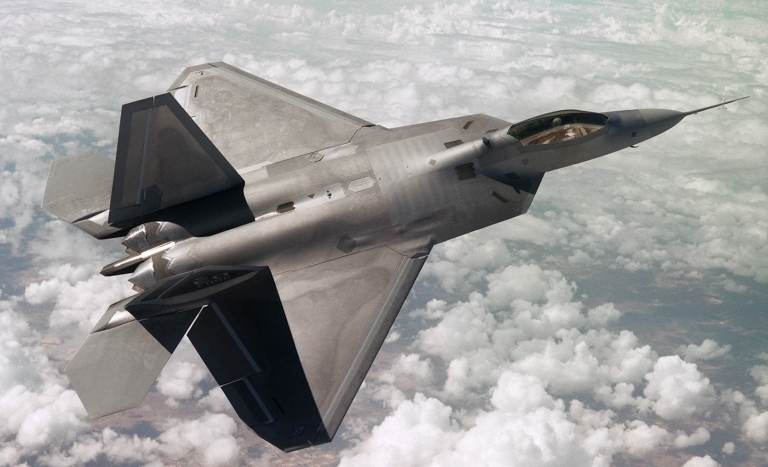
It
is by turning back to the last two decades of that history that we can
fully understand the evolution in tactical thinking that spawned the
design concepts now embodied in the ATF. It was in fact about twenty
two
years ago that a pivotal point in the development of air combat tactics
was reached, and a new outlook developed on the issue of air combat
performance parameters. The setting for this situation was more than
well publicised, as the USAF hammered the Third World infrastructure of
North Vietnam with weapons designed to destroy industrialised
economies.
TAC flew daily raids with fast big and well armed F-105D Thuds and
F-4C/D Phantoms. The Thud was initially designed for tactical nuclear
strikes and thus sacrificed manoeuvring ability for speed at low level,
as such it had no serious competitors in its class. Vietnam saw the
Thuds loaded up with 500 lb and 750 lb iron bombs flying low level dive
bombing raids on a range of targets, the Thuds carried only an internal
20 mm gatling for self defence.
The
Phantom in its C and D incarnations was a minimal modification of the
US
Navy's established F-4B fleet defence interceptor, the F-4 had a useful
bomb carrying ability but significantly served as the USAF's principal
air superiority aircraft. It was armed with semi-active radar guided
AIM-7D/E missiles, heatseeking AIM-9B and AIM-4D missiles and in some
instances, 20 mm gatling centreline gunpods. Their opposition was a
mixed bag of second hand MiG-17F, MiG-19S/F-6 and MiG-21F aircraft,
armed with 23 mm and 30 mm guns and in some instances, AA-2 Atoll
heatseeking missiles. The aircraft were flown by Vietnamese, Russian,
Czech, Polish and East German pilots, the latter not publicised for
obvious propaganda reasons. The USAF did not fare very well, achieving
an air-air kill ratio of 2.18:1 in the period between 1965 and 1968.
The
reasons were manifold, as inadequacies in missile performance, weapon
systems and tactics combined with absurd rules of engagement (ROE)
offered every imaginable advantage to the Communists, who did not
hesitate to exploit them. What had become very apparent was that the
performance characteristics of the aircraft and weapons used were ill
matched for the kind of engagements which were entered. The MiGs were
light VFR only fighters with simple gyro stabilised gunsights and no
fire control worth mentioning, the 17 and 19 being both optimised for
climb performance at high subsonic speeds. This gave them good turning
ability and respectable subsonic acceleration which combined well to
provide the basic elements of good gunfighting air combat performance.
The
Phantoms were IFR supersonic interceptors, with air intercept radar,
two
man crew, beyond visual range (BVR) radar guided missiles and tail
aspect only heatseeking missiles, both types optimised for killing high
flying bombers. The missiles lacked the manoeuvre performance to
successfully kill a nimble and small target unless launch conditions
were optimal and the target's manoeuvre options were highly restricted.
The Phantom's advantage in transonic acceleration and climb performance
was balanced by high wing loading and unspectacular turning performance.
The
USAF was clearly unhappy about this situation and measures were sought
to improve kill ratios. The demand for a gun and better turn
performance
spawned the F-4E with a stretched fuselage, improved fuel capacity,
chin
mounted M61 20 mm gatling gun and manoeuvring slats. The same pressures
also led to a major review of air-air tactics which saw the adoption of
energy manoeuvrability as a fundamental of the new air combat
manoeuvring doctrine. Conceived by a serving USAF fighter pilot, Major
John Boyd, energy manoeuvrability revolved about the use of an
aircraft's energy state (ie speed/altitude) to gain a positional
advantage in a manoeuvring engagement, thus gaining a firing
opportunity.
Because the close-in air-air weapons of the period were guns and tail
aspect heatseekers, the best firing opportunities resulted from tail
aspect shots, this in turn dictated that an aircraft must possess
superior sustained turning, acceleration and climb performance to
defeat
an opponent. While the F-4 had the acceleration and climb performance
to
kill most current opponents, it was clear that the next generation of
fighters had to possess even greater thrust/weight ratios and much
better sustained turning performance. The latter was simply not
achievable by modifications to existing types which had their origins
in
the late fifties and hence were aerodynamically highly optimised to
strike or interception roles.
The
USAF initiated its FX program, while the USN discarded its troubled
F-111B bomber turned interceptor in favour of the new VFX. Both the VFX
and FX exploited new propulsion technology, discarding afterburning
turbojets in favour of afterburning turbofans which offered much better
specific fuel consumption in dry thrust and a higher ratio of
afterburning thrust to dry thrust. Experience in Vietnam clearly
indicated that the endurance/combat radius of the 400 NM class F-4 was
inadequate and hence the VFX and FX were designed to a 1000 NM class
combat radius. Climb and turn performance dictated low wing loading and
good AoA performance this in turn shaping the wing and inlet designs.
First to fly was Grumman's VFX, designated the F-14A, a large twin with
swing wings and a pair of TF-30 fans. The F-14A had a large bubble
canopy for good visibility during dogfights, a Head Up Display (HUD)
gunsight, computer controlled automatic wing sweep and glove vane
positioning, a massive AWG-9 pulse Doppler air intercept/fire control
radar system capable of tracking multiple targets in ground clutter and
an internal M-61 gun. It was bigger, more complex and more expensive
than the F-4, but it also offered agility and manoeuvrability without
precedent. The first of the teen series fighters had thus made its mark.
The
20,000 lb class TF30-P414 powerplants fitted to the F-14A were a stop
gap measure which offered a 1:1 class thrust/weight but not the
stunning
1.2+ class thrust/weight sought by the Navy, that was to occur with the
F-14B which was to be fitted with F401-P-400s, navalised derivatives of
the emerging Pratt&Whitney FX powerplant. For budgetary reasons
this
never eventuated, the F-14A having to wait until the nineties for the
30,000 lb class F-110-GE-400 powerplant.
The
USAF's FX subsequently flew in 1972, taking advantage of the 25,000 lb
class F100-PW-100 powerplants and optimised for energy manoeuvrability.
Like the F-14 it had a large bubble canopy, HUD, powerful pulse Doppler
fire control radar, low wing loading and internal gun. Because it was
smaller and lighter than the F-14A, it offered a stunning 1.4:1 class
thrust/weight ratio and thus set the standard for air combat fighters
(see AA Sept/Nov 84).
By
the mid seventies the F-14A and F-15A entered service and quickly
established their superiority over existing aircraft. Cost of ownership
had however proven to be a major issue as both aircraft cost much more
to buy and even more to maintain, given their more complex powerplants
and avionic systems. Under pressure from legislators, the USAF
initiated
the Light Weight Fighter (LWF) program to supplement the F-15 with a
smaller and much cheaper VFR dogfighter, an aircraft armed with guns
and
heatseeking missiles and equipped with a small pulse Doppler radar
optimised for dogfighting alone.
Northrop bid their YF-17, a derivative of their P-530 lightweight
fighter, while General Dynamics bid their YF-16, derived from a
fly-by-wire relaxed static stability technology demonstrator. The YF-17
Cobra was a small twin with two 'leaky turbojet' YJ101-GE-100
powerplants and a hybrid planform comprised of massive Leading Edge
Extension (LEX) strakes and a moderately swept wing. The YF-16 was
fitted with a single F100 common to the F-15 and employed extensive
wing/body blending, also using strakes and a moderately swept wing. The
YF-16 was the first aircraft ever built to be statically unstable and
relied upon a triple redundant analogue computer system to remain
flyable.
The
LWF flyoff was won by the YF-16 due in no small measure to its
powerplant commonality with the F-15, and to its smaller size and
somewhat better thrust/weight ratio performance. Subsequently selected
as the standard NATO air superiority fighter, the F-16 is today one of
the mainstays of Western air power.
Like
the USAF the Navy came under increasing budgetary pressure from
legislators, who quickly quashed the Navy's plans for a fleet of
supercarriers equipped with a force of air superiority F-14Bs and
strike
F-14Cs, the latter a strike fighter derivative of the F-14B intended to
replace the underpowered A-6 bomber. The Navy were directed to select
one of the two USAF LWF contenders under the Naval Air Combat Fighter
(NACF) program, the intention being being to replace the ageing A-4,
A-7
and F-4 fleets with a single dual role lightweight fighter bomber. Many
in the US Navy opposed this move, which largely defeated the Navy's
strategy of acquiring a 1000 NM radius air superiority/strike force.
The
Navy eventually selected the F/A-18A, a substantial redesign of the
YF-17 airframe with greater internal fuel capacity, bigger 16,000 lb
class F404 engines and BVR missile capability, absent on the smaller
F-16. The F/A-18A was designed to rigid reliability and maintainability
specifications, which substantially increased the cost of the aircraft,
which by then had acquired a very sophisticated suite of avionic
systems, imposed largely by the need for one airframe to fulfill two
diverse roles. Another side effect of this program was the 'detuning'
of
the F404 powerplant's performance to improve reliability and lifetime.
The
F/A-18A also employed fly-by-wire, but employed a sophisticated
quadruplex digital system where software changes could be employed to
'tweak' handling characteristics. The avionic system was built around
multiply redundant serial Mil-Std-1553B databusses and employed dual
redundant digital computers.
With
the entry into service of the F/A-18A the US services completed their
reequipping with teen series fighters, eventually building up a force
of
several thousand aircraft of these four basic types.
The
basic philosophy of high thrust/weight ratio and sustained turning
performance in transonic dogfights shaped these aircraft
aerodynamically
and hence imposed fundamental constraints to the other performance
characteristics of this family of aircraft.
Evolution did not stand still however, and the early eighties saw the
deployment of one of the most significant air combat weapons of its
time
- the all aspect heatseeking Lima model of the established AIM-9
Sidewinder missile. The AIM-9L did not require a tail chase position to
lock on to a tailpipe, it was quite happy to lock on from any angle
including 12 o'clock ie head-on. Soon after deployment the AIM-9L
proved
that much of the air combat tactics textbook had been obsoleted, in
that
instantaneous turning performance became far more important than
sustained turning performance. The ability to point the nose at an
opponent quickly and loose off a missile became far more important than
the ability to follow through multiple turning manoeuvres to acquire a
tail aspect gun/heatseeker firing position. While a tail aspect
position
did improve the kill probability of the missile by reducing the
target's
evasive manoeuvre options, the AIM-9L's all aspect performance was
still
superb, as learned the hard way by the Argentine and Syrian air forces
in 1982.
Clearly the day of the classical dogfight was almost over, in that the
first aircraft to acquire its opponent would be first to fire and most
likely to win the engagement. Only if the first firing opportunity were
to fail and the combatants were to pass each other and then engage in a
turning dogfight, was there a major requirement for sustained turning
performance. Yet again, however, the all aspect capability of the
AIM-9L
would convert fleeting nose on target opportunities into real firing
opportunities.
The
first aircraft to take advantage of this situation was the Navy
F/A-18A,
which had its flight control software tweaked up to optimise
instantaneous turn performance, this combined with its sophisticated
HUD
and fire control radar dispelled any doubts of the aircraft's
lethality,
given earlier criticism of its low (ie 1.1:1 !) combat thrust/weight
ratio. Acceleration and climb performance, and low energy bleed in
manoeuvring at transonic speeds were the key parameters in this class
of
engagement.
A
new philosophy for air combat tactics was thus developed by the USAF,
who envisaged long range medium to high altitude penetration of hostile
airspace by supersonic cruise capable fighters with all aspect fire and
forget missile armament. A key element in the new strategy was the
AIM-120 Amraam missile (AA Sept 86), an active radar guided intelligent
fire and forget BVR missile, designed to replace the established
semi-active radar guided AIM-7. Coupled with a suitable fire control
radar the AIM-120 allows a single fighter to salvo up to eight rounds
at
eight separate inbound targets within the acquisition geometry of the
fire control radar.
Manoeuvring at sustained supersonic speeds, the new look air
superiority
fighter could outmanoeuvre SAMs and most AAMs, while always retaining
an
energy advantage over the subsonic/transonic speed range optimised teen
series turning dogfighter. The aerodynamic and propulsion design
compromises which supported sustained turning performance at high
subsonic and transonic speeds seldom improved the ability of the
aircraft to sustain high energy manoeuvres at Mach 1.5 class speeds,
where much of the wing was enveloped in the shock cone produced by the
nose of the aircraft.
The
philosophy of first-look first-shoot reflected in the need for superior
sensor capability and low observability ie Stealth. The former and
latter requirements result in the need for a frequency/spatially agile
radar and high performance InfraRed Search & Track (IRST), while
the
latter requirement imposes the need for all of the tricks of the
Stealth
trade, ie shaping, skinning and detailing.
The
first aircraft to fly which embodied some of the new technology was the
ill-fated F-16XL. A radical redesign of the F-16A, the XL was a
supersonic cruise demonstrator with a cranked arrow delta wing
optimised
for that flight regime. The aircraft was, on the strength of published
reports, a major technical success, with two demonstrators eventually
flying. The highly swept inboard wing section of this aircraft produced
substantial vortex lift at supersonic speeds, while also improving
instantaneous turn rate and extending the 9G manoeuvre envelope well
above Mach 1. An additional benefit of the new configuration was a
substantial increase in internal fuel capacity, providing a 120%
improvement in combat radius performance.
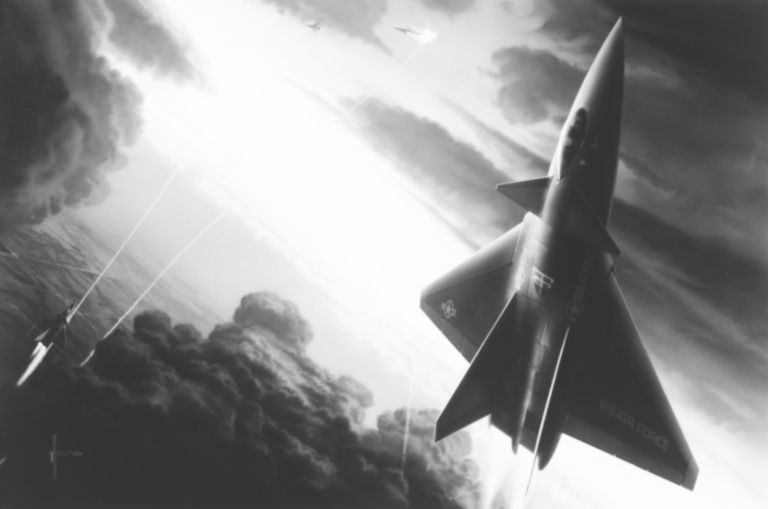
Early
Lockheed ATF Concept (1988).
The
F-16XL suffered the fate of many pioneering aircraft before their time,
its F-16E dual role strike fighter derivative lost out in a flyoff
against MDC's bigger and more capable F-15E Strike Eagle, thus ending
all prospects for its eventual production. Many observers attributed
its
demise to a political strategy played by the USAF, to prevent an older
generation airframe derivative from being used by legislators as an
excuse to kill off or postpone the ATF program. Equipped with Amraam,
higher thrust engines and new radar, the F-16XL could cover a large
part
of the role envisaged for the ATF at substantially lower unit and
program costs. As an older generation airframe however its infrared and
radar signatures are substantial and this would greatly reduce its
effectiveness (although trivia of this nature hardly ever bother astute
decisionmakers such as politicians...).
The
ATF program had its origins in numerous USAF air combat studies carried
out in the late seventies and early eighties, when intelligence
information revealed the Soviets' early flight testing of the Fulcrum
and Flanker. From the observed geometry of the airframes it was clear
that both types would have the vortex lift performance to challenge the
teen series aircraft in turning dogfights, by the same token both
Soviet
fighters would be handicapped by their geometry in both supersonic
manoeuvre and low observability performance.
The
ATF was to be the successor to the F-15, a long range air superiority
fighter with the performance to kill any other tactical aircraft and
the
operating radius to threaten targets deep inside the USSR while flying
from bases in Western Europe. This was to be achieved by the use of a
highly integrated airframe/systems/propulsion design exploiting
advanced
aerodynamics, engines and stealth technology, the latter to delay an
opponent's initial firing opportunity for as long as possible, and thus
capitalise on the large Radar Cross section (RCS) of the Fulcrum and
Flanker.
Subsequent to studies, an RFP was issued in July 1986, and two
contractor teams, Northrop/McDonnell-Douglas and
Lockheed/Boeing/General
Dynamics were selected in October 1986 for the initial 50 month
demonstration/validation phase flyoff. The rollout of the prototypes
was
initially scheduled for mid 1989, but ongoing slippages have delayed
this until the middle of last year.
Part
2 provides a technical comparison of the YF-22A and YF-23A prototypes
MDC F-4 Phantom II. The F-4 was the
mainstay of the USN's and USAF's tactical fighter force in the
SouthEast
Asian conflict. The Phantom offered superb acceleration and climb
performance for its day, while carrying an impressive air-air payload
of
4 heatseeking AIM-9D and 4 semi-active radar AIM-7E missiles. In
engagements with the smaller and nimbler NVAF MiGs the F-4 was hampered
by poor missile performance and reliability, inadequate radar lookdown
performance and the absence of a gun for close in engagements.
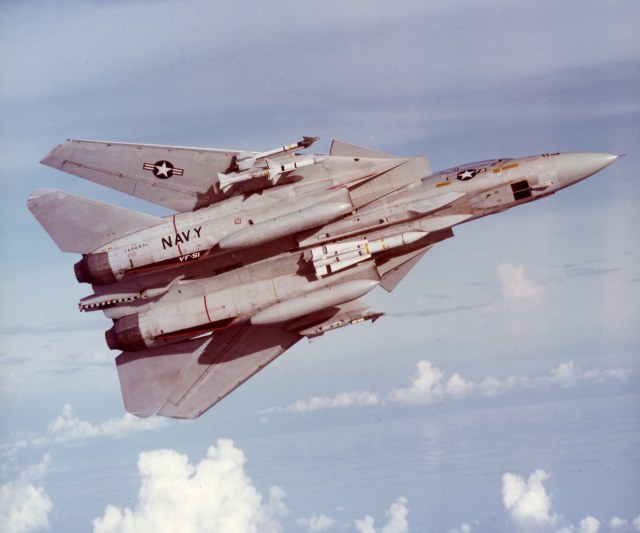
Grumman F-14A Tomcat. Grumman's large F-14 fighter was the first of the
teen series aircraft to fly and deploy. It was equipped with a pair of
20,000 lb class TF-30 afterburning fans and a computer controlled
variable geometry wing to provide superb turning and acceleration
performance, while its massive pulse Doppler AWG-9 fire control radar
and Head Up display allowed the targeting of 100 NM class AIM-54
Phoenix
missiles, AIM-7 Sparrow, AIM-9 Sidewinder missiles and an internal
M-61A1 20 mm gun. It has remained a formidable dogfighter to this day.
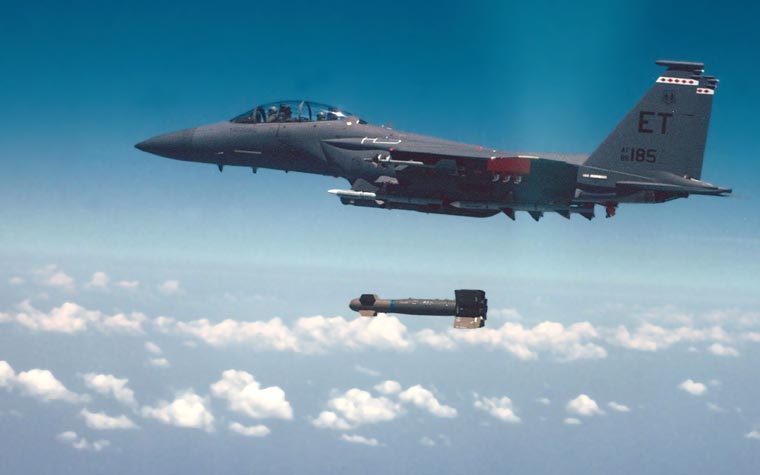
MDC
F-15A Eagle. The F-15A was designed, like the F-14A, for high
thrust/weight ratio to provide superlative acceleration, climb and turn
performance. Like the F-14, it is equipped with a high power long range
lookdown/shootdown pulse Doppler radar. Armed with a mix of AIM-7 and
AIM-9 missiles and an internal M-61 gun, the F-15 has repeatedly
demonstrated its capability in the Middle East. The most recent
subtype,
the dual role strike fighter F-15E, is structurally strengthened for 9G
manoeuvres.
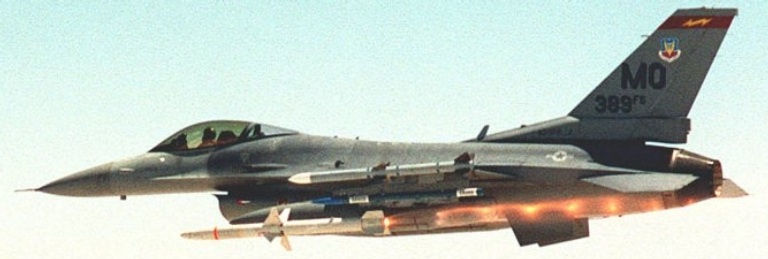
Dubbed the 'Electric Jet', GD's F-16 was the first tactical aircraft to
employed relaxed static stability and fly-by-wire control. Initially
acquired as a low cost VFR dogfighter armed with an internal M-61 gun
and heatseeking AIM-9 missiles, the later F-16C is a truly multirole
tactical aircraft, with wide angle holographic HUD, and provision for
Lantirn terrain following radar/FLIR pods and the AIM-120 Amraam BVR
missile.
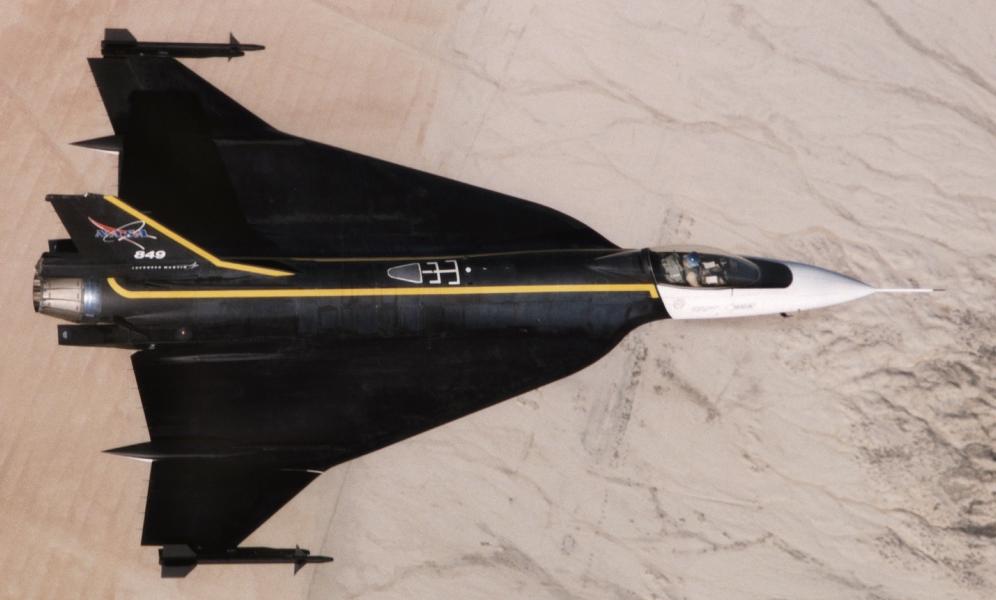
The
F-16XL was a supercruise technology demonstrator derived from the basic
F-16 airframe/powerplant. The cranked arrow delta wing allowed the
aircraft to cruise supersonically on dry thrust, improved the manoeuvre
envelope substantially while providing enough additional internal fuel
capacity to increase the combat radius by 120%. Sadly it never entered
production, losing to the F-15E in a competitive flyoff for the Dual
Role Fighter program. As a teen series airframe lacking stealth
capability, it cannot compete with the newer ATF aircraft.
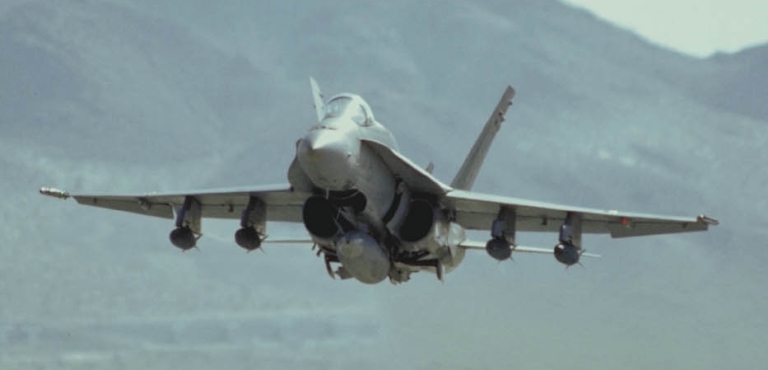
Using
a hybrid planform wing and digital fly-by-wire, the MDC F/A-18A was the
last of the teen series fighters. It was the first tactical aircraft to
employ a fully digital Mil-Std-1553B bussed avionic system under the
control of redundant digital computers. A multirole derivative of the
YF-17 airframe, the later F/A-18 is a fully capable all weather strike
fighter which retains excellent air superiority performance.
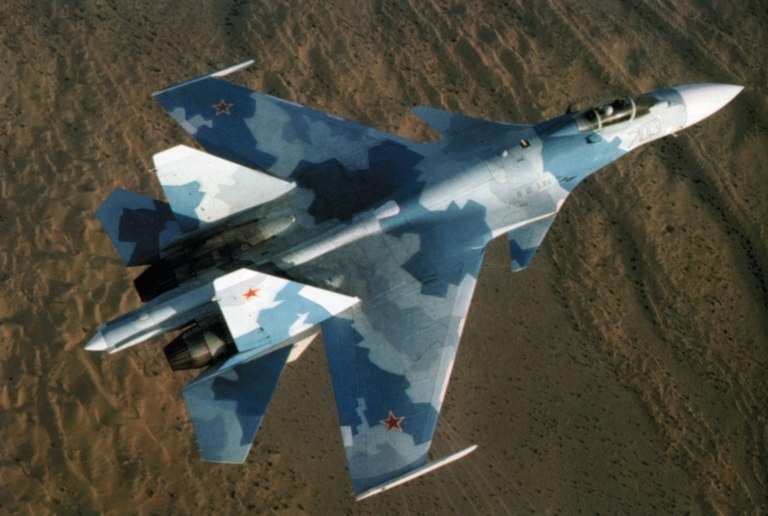
The
Su-27 Flanker is the most capable aircraft in the Russian inventory and
is expected to be a hot seller in the Third World market (Above is the
aircraft in Chinese livery with R-77 Adder radar guided missile and
R-73
IR missile below). Aerodynamically it reflects the design philosophy of
the teen series aircraft, employing vortex lift, high thrust/weight
ratio and fly-by-wire control. Equipped with a large pulse Doppler
radar, internal 30 mm gun, BVR and heatseeking missiles, it is a
formidable opponent. Recently tested on the V-MF's new CVAN, the
Flanker
has the combat radius and performance to contest any teen series
aircraft.
|
Part 2: YF-22A and YF-23A -
A
Technical Comparison
At the time of writing the
Northrop/MDC YF-23A and Lockheed/B/GD YF-22A had both completed their
respective demonstration/validation flight test programs . While the
USAF have not revealed much about the internals and performance of the
aircraft, their airframe geometry and known powerplant parameters
reveal
much of their design philosophy and performance. Both aircraft reflect
their prime contractors' respective philosophies of stealth aircraft
design as much as they reflect their common mission profile.
Principal airframe/propulsion design objectives were sustained
supersonic cruise on dry thrust, high energy manoeuvrability, superior
combat radius to the F-15 with all weapons and fuel carried internally
and low signatures.
Both
ATF prototypes are approximately 10% larger than the F-15 and both
carry
approximately twice the internal fuel of an F-15C, while both have
about
50% more wing area at about 30% greater combat weight. As such both
aircraft clearly illustrate the long range air superiority mission
which
was originally envisaged for the aircraft, penetrating deep into Soviet
airspace to destroy air defence aircraft and to disrupt Soviet
offensive
air operations. The decline of the Soviet empire during the last 18
months has understandably led to many US politicians calling for the
scrapping of the ATF program, in view of the 'diminished threat'. This
myopic posture needless to say wholly disregards the fact, that the
USSR itself is quite unstable and could well slip back into hardline
Stalinism, and also ignores the reality that the USSR will sell the
Flanker and Fulcrum to any party who can pay for it. It is likely that
that these capable teen series class aircraft will become as common in
the Third World as the ubiquitous Fishbed. The mere perception that a
capability matching that of the frontline Western aircraft is present
will be destabilising - the instance of Iraq with its Fulcrums and
Fencers is a case study, their tactical and technical incompetence
clearly underscoring this sad phenomenon.
The
reality is that capabilities are a good measure of intent, it is
unrealistic at the least to assume that any nation will expend vast
sums
of money to acquire specific weapons systems without seeing how that
expenditure will further its interests. Long range air superiority
aircraft such as the Flanker serve a clearly defined role, offensive
strategic air war.
How
the ATF performs this role is best judged by a closer look at the
design
philosophy of the airframe, propulsion and weapon system.
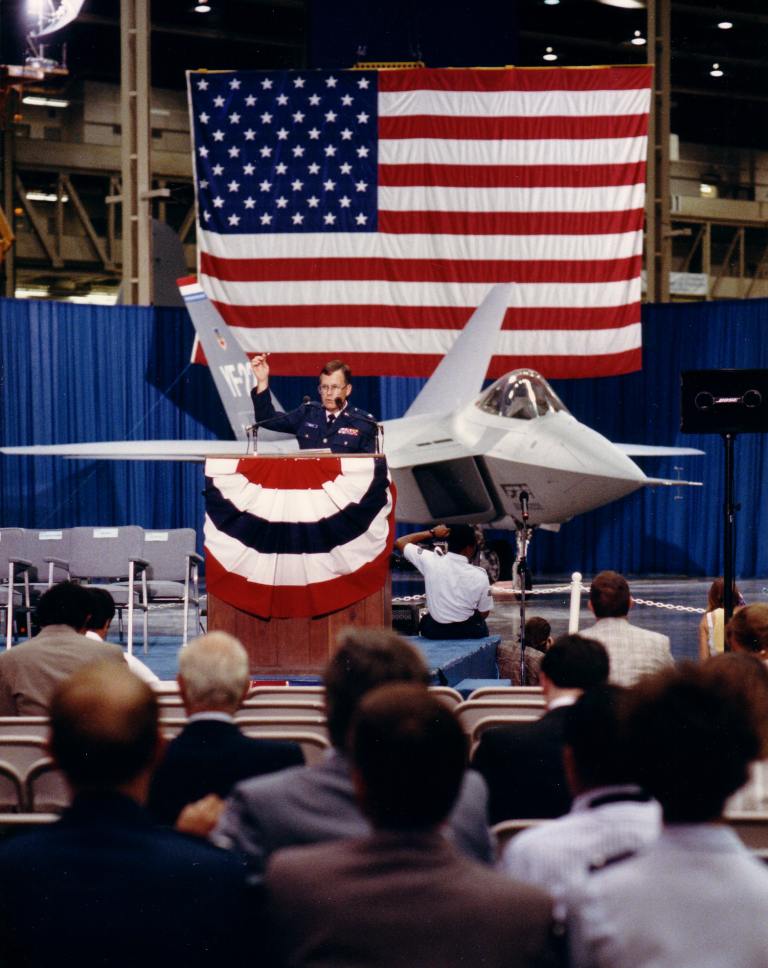
Airframe Design
The ATF airframes represent another quantum leap in air superiority
airframe design, as great as that represented by the teen series
fighters. Two new and key capabilities were integrated in the ATF
program, low observability (ie stealth) and supersonic cruise.
The
objective of low observables is to reduce the performance of hostile
radar and infrared surveillance, tracking and guidance systems.
Existing
airframes perform poorly in this respect, and thus only a new airframe
design can address the problem.
Supersonic cruise serves several purposes, providing for fast and deep
penetration into hostile airspace, while offering the supersonic cruise
fighter a major energy advantage over subsonic/transonic dogfighters
which it can both outmanoeuvre and outlast in a supersonic engagement.
The high corner speed of such aircraft also provides a major
manoeuvring
advantage when evading SAMs at altitude, enhancing survivability on
deep
penetration missions. Supercruise required major advances in propulsion
technology and nontrivial concessions in airframe design.
Low
observability in the ATF designs is achieved by a range of measures,
how
these are applied clearly illustrates the heritage of the respective
designs.
The
Lockheed/B/GD YF-22 employs planform shaping and faceting with blended
facet boundaries, the latter a necessary concession to high performance
aerodynamics. This is apparent in the shape of the nose, the fuselage
sides about the inlets and engines, and the upper forward fuselage.
Lockheed/B/GD used serrated edges extensively, as with the F-117A, to
control the returns from panel boundaries, this is very visible on the
undercarriage and weapon bay doors.
The
planform results in a multiple lobe design, as the boundaries of the
major surfaces are not parallel with respect to each other. Planform
return lobe structure is defined by the radiation pattern lobes
resulting from surface wave reflections which occur at the leading and
trailing edges of the airframe's major surfaces. The objective of
lobing
is to concentrate this unavoidable radar return into specific
directions
so as to minimise frontal/aft/beam aspect return and maximise
scintillation in the direction of the lobe. Scintillation is a measure
of how rapidly the size of the return varies with angle, the greater
this variation, the more difficult a target is to track. The lower the
number of lobes and the narrower the lobes, the lower the probability
of
detecting any return.
The
Northrop/MDC YF-23 employs planform shaping with extensive blending,
the
latter technique used to advantage with the large B-2A. Blending has
the
major strength of not compromising high speed aerodynamics, the blended
airframe offering very low drag by avoiding vortices which may be
produced by a faceted geometry. In addition to RCS reduction through
shaping, the YF-23 also employs carefully shaped exhausts to conceal
the
engine hot end, yet another technique developed during the B-2A program
[Editor's Note 2005: the exhaust troughs used air cooled inserts
resulting in the lowest IR signature of any fighter ever built].
The
unusual 'diamond' planform of the YF-23 is a 2 major lobe design, as
all
major edges fall into groups of two parallels.
The
result of the low observables techniques employed with these aircraft
is
a major reduction in aircraft detectability by radar, and in the YF-23,
also detectability by Infra-Red Search & Track (IRS&T) systems.
This will radically shrink the usable envelope of hostile radar guided
weapons and in the instance of the YF-23, also heatseeking weapons.
Lockheed/B/GD chose a somewhat conservative hybrid planform airframe
layout, reminiscent of the F-15 and F/A-18, with closely spaced
engines,
long inlet tunnels, outward canted vertical tails and rudimentary
strakes over the inlet boxes to promote vortex lift over the outboard
wing sections at high AoA. The characteristics of this general layout
are well understood, the forward sloped inlets providing good airflow
characteristics at high AoA and the conventional tail providing good
controllability under such conditions, apparently earlier attempts at
using a V-tail did not yield the desired results. The close spacing of
the engines reduces inertia in the roll axis, but may penalise
survivability. Weapon bays are located on the sides of the inlet boxes
and a single central bay is located beneath the centresection, all
located well aft of the inlet to preclude ingestion problems. Typically
AIM-9s fit in the inlet bays and AIM-120s in the split central bay.
The
single piece canopy cockpit is well elevated to maximise the pilot's
situational awareness.
Northrop/MDC chose a far more radical airframe layout, driven by the
objectives of stealthiness and supercruise. The extensively blended
fuselage has rudimentary chines which smoothly blend into the wing
leading edge, the blending allowing good area ruling and low supersonic
drag. The low wing aspect ratio is used to optimise supercruise
performance. The ventral trapezoidal inlets feed the engines via
stealthy S-bends, and the rear boattail and submerged dorsal exhausts
were specifically aimed at low drag and infrared signature. The YF-23
employs an unconventional V-tail with a planform consistent with the
airframe lobing strategy. The large centresection area will provide
substantial body lift at high AoA thus improving turn performance, a
technique used in the F-14 and Flanker. While the widely spaced engines
result in some roll rate penalty, they are sufficiently separated to
avoid fratricide in the event of turbine breakup. Two tandem weapon
bays
are employed, the aft bay is reported to be very large and contains
pairs of staggered AIM-120s, the forward bay carrying AIM-9s.
The
YF-23 employs a two piece canopy, the cockpit is like it's competitor's
well elevated for good visibility.
The
exhausts of the two aircraft differ radically. Lockheed/B/GD had chosen
a layout aimed at maximising lower speed manoeuvrability via the use of
thrust vectoring, even though this was not a mandatory USAF
requirement.
Two dimensional thrust vectoring nozzles provide vectoring to enhance
response in pitch. Northrop/MDC on the other hand rated stealth and
drag
so important, that they employed a serrated planform beavertail with
B-2-like submerged ventral exhaust troughs. This approach reduces both
depressed tail aspect infrared emissions and tail aspect radar
cross-section, but precludes any vectoring.
Both
prototypes are reported to employ relaxed static stability, with
multiply redundant digital fly-by-wire control systems.
The
navalised ATF derivative planned to replace the Grumman F-14 as the
USN's principal air superiority fighter has yet to materialise.
Lockheed/B/GD have proposed a variable geometry wing derivative of the
TAC design, in order to accommodate the Navy carrier recovery an launch
requirements, ie low speed on approach and high lift at low speed on
catapult launch. At the time of writing no information was available on
the Northrop/MDC proposal.
Propulsion
The unique and new supersonic cruise mission profile of the ATF has had
a major impact upon the powerplants to be used for the aircraft. The
higher combat weight of the aircraft in comparison with the F-15
imposed
a need for greater installed afterburning thrust, in the 35,000 lb
class
per engine, to maintain the preferred 1.4:1 class combat thrust/weight
ratio, while the supercruise profile imposed the need for high dry
thrust particularly within the supersonic part of the envelope. The
latter requirement was particularly painful, as it forced a move to
higher temperatures within the engine, particularly the turbine.
The
two bidders for the ATF powerplant are Pratt & Whitney and General
Electric with their YF119 and YF120 designs respectively. The P&W
YF119 is the lower risk of the two designs, an advanced low bypass
ratio
turbofan. The GE YF120 is more radical, as it is a variable cycle
engine
capable of adjusting its bypass ratio to the optimum for a given flight
regime.
GE's
involvement with variable cycle engines dates back a decade, with a
major technology demonstration program built around a substantially
redesigned YJ101 (former YF-17) powerplant. This was followed by work
on
an F404 derivative, this providing the foundation for GE's variable
cycle technology. The core of the YF120 was derived from work done
during the government sponsored ATEGG (Advanced Technology Engine Gas
Generator) and JTDE (Joint Technology Demonstrator Engine) programs.
Subsequently early development XF120 engines underwent testing at the
USAF Systems Commands AEDC facility. Ground test prototype YF120s have
been under test since late 1989.
Internal details of the YF120 are, not surprisingly, classified. The
engine is known to be a two shaft design with a minimum number of
rotating stages, a fan which has been speculated to be a single stage
design and a compressor using integrated bladed rotors. In common with
earlier GE VCEs, the YF120 uses VABI (Variable Area Bypass Injector)
technology to alter engine bypass ratio. The YF120 is reported to use
aerodynamically actuated VABIs, in which respect it differs from
earlier
designs which used mechanical actuation. Typical VABI technology used
in
earlier GE designs saw the use of sliding sleeves which would reduce
the
cross section at the fan exit entry to the bypass duct, and at the
tailpipe exit from the bypass duct.
This
arrangement allows the engine to smoothly optimise its bypass ratio to
the flight regime. For maximum afterburning thrust on takeoff or
efficient subsonic long range cruise, a high bypass ratio is set. For
supersonic cruise a turbojet is approximated, with very low or zero
bypass ratio. Turbojets are considered optimal for supersonic flight as
their dry thrust drops far more slowly than that of a fan with
increasing vehicle airspeed. The ATF flight profiles are sufficiently
unconventional to create major difficulties for a fixed bypass ratio
engine designer attempting to reconcile the diverse demands of lower
speed operation and supersonic cruise.
This
must have been the case with P&W, who have bid a fixed bypass ratio
turbofan derived from the ATEGG/JTDE programs and the company's
existing
F100 family of fans.
Published reports indicate the GE engine has demonstrated better
supercruise performance than its conventional rival and it is very
likely that GE's gamble with a more radical technology will yield the
desired payoff. The gain in overall engine performance in comparison
with existing teen series fighter powerplants is clearly illustrated by
a Lockheed/B/GD flight envelope chart for the YF-22 which shows a
military thrust envelope for the YF-22 as greater at all airspeeds and
altitudes than the afterburning envelope of the F-15C. In the
thrust/drag limited low altitude regime the YF-22 dry envelope is 7%
greater than that of the F-15C, given the similar configuration of both
airframes and greater wetted area of the YF-22 this suggests dry thrust
in excess of 25,000 lb per engine.
Avionics, Cockpit and
Weapon System
Avionics is an area where the ATF will offer a radical improvement over
existing systems. From the outset avionics were a key aspect of the ATF
program. Initial studies were aimed at a distributed architecture
designated Pave Pillar, the objective of which was to employ physically
separate common computing modules for the aircraft's vital systems.
This
would provide superior tolerance to battle damage and internal systems
failures, while reducing the requirement for unique spares modules. A
high level of integration was also sought in the comm/nav systems and
electronic warfare systems, under the USAF Icnia (Integrated
Communications, Navigation and Identification Avionics) and Inews
(Integrated Electronic Warfare System) technology development programs
respectively.
A
major system level requirement was supportability in the field and very
high reliability, the latter a must in view of the complexity of the
aircraft. The scale of effort in this area is reflected by a
requirement
for a combat turnaround of 15 minutes (cf 35 minutes for F-15), a
requirement for 9 support personnel/airframe and 6.8 C-141 loads of
support equipment, in comparison with the existing 17 for a 24 aircraft
TAC squadron.
The
YF-23 avionic system is built around a core integrated system using
Unisys 32 bit GPPE (General Purpose Processing Element) modules. The
original 3 CPU 1750 architecture mission computer arrangement was
discarded as the support hardware requirements were excessive, and the
computational power inferior.
Signal processing is done with a single dedicated processor, sliced
between two large physically separated 75 card racks, with redundant
functional modules spread between the racks to enhance survivability.
The
YF-22 avionic system is built around Hughes CIP (Common Integrated
Processor) modules. Lockheed/B/GD have apparently opted for
unconventional liquid cooling of the processor modules to reduce
hardware operating temperatures.
Weapon system software is to be implemented in US DoD standard ADA
language, it is not clear whether the production code will be to
current
ADA or revised ADA 9X standard.
The
INEWS electronic warfare systems are being developed by two contractor
teams, TRW/Westinghouse/Tracor/Perkin Elmer for the YF-23 and
Sanders/GE/Motorola/HRB for the YF-22.
The
sensor suite will be dominated by an active phased array radar. The
radar will employ electronic antenna scan exploiting over 1,000
transmit/receive/phase-shifter elements, each of which is a wholly self
contained module. This arrangement results in a highly robust design
which doesn't require mechanical pointing, as main lobe shape and
direction are controlled electronically, and which gracefully degrades
in performance as modules fail. The use of electronic beam
shaping/pointing provides major advantages as this class of radar may
timeshare its antenna between modes, optimise lobe shapes to modes,
tolerate violent manoeuvring and also selectively direct nulls at
troublesome jammers as a potent ECCM. Both contenders would employ a
Westinghouse/TI radar design, initially flown in 1989 and derived from
the URR (Ultra Reliable Radar) program.
This
radar is the most radical step in fighter air intercept radar design
since the first pulse Doppler sets were introduced in the early
seventies, and offers diverse upgrade paths through software changes in
the beam control subsystem and the signal processing subsystem.
The
radar is to later be supplemented by an EOSS (Electro-Optical Sensor
Suite) which is essentially an advanced IRS&T set. Both contenders
are to employ a Martin Marietta/GE system using focal plane array (FPA
-
see earlier TE) technology. The advantage in a FPA design is higher
sensitivity and the absence of moving parts, scanning being
accomplished
electronically. At the time of writing it was unclear as to whether a
cheaper mid-infrared PtSi or InSb design would be adopted, or whether a
long-infrared HgCdTe design would be employed. While the latter can
detect airframe skin friction, it is more demanding in cooling and
signal processing. The difficult requirement is to detect and track
targets against an IR background at low level, at altitude the
background environment is easier to deal with. At the time of writing
the EOSS was deferred as it was considered too immature for a low risk
production design.
The
cockpits of both the YF-22 and YF-23 will be conventional 'glass'
arrangements, although Lockheed/B/GD have opted for LCD technology in
preference to CRT displays. The YF-22 uses no less than 6 LCDs,
typically providing 512x512 pixel resolution with 4,096 colours. An
advanced HUD will be employed, as will the USAF's new G-suit technology
currently being introduced on the F-15. Both contenders are reported to
use conventional control layouts, the sidestick controller not being
used.
Flight testing of both avionic suites has taken place on dedicated
testbed aircraft, Boeing using a 757 and Northrop/MDC a well reworked
BAC-111.
The
ATF will be armed primarily with the AIM-120 AMRAAM ARH BVR missile,
supplemented by a short range all aspect heatseeker, the AIM-9M at this
time. A design requirement is the carriage of four Amraams, these must
be ejected from internal bays at launch. An internal gun will be
employed, although it appears that the gun is absent on all prototypes.
Performance
It is clear from published accounts that the ATF is an enormous step
forward in aerodynamic and low observables performance in comparison
with the teen series fighters and their Soviet counterparts. Both
competitors have repeatedly supercruised on dry thrust with speeds of
1.58 Mach reported for both airframes with YF-120 powerplants. In
addition the YF-23 attained 1.8 Mach in afterburner and reports
indicate
that the final maximum speed figures have been classified by the USAF.
Both
airframes offer 1.4:1 class combat thrust/weight ratio performance and
combat wing loadings well below 60 lb/sqft, therefore the energy
manoeuvrability performance will equal if not exceed that of the F-15.
Controllability at high AoA has been reported as excellent for both
types, in the absence of hard data it is therefore difficult to
estimate
whether Lockheed/B/GD's claimed advantage in manoeuvrability will be
decisive.
Tactical radius and cruise speed are also critical parameters for the
mission, in both areas the ATF is well ahead of the teen series
fighters. Again in the absence of hard figures it is difficult to
establish whether Northrop/MDC's greater speed and radius performance
are a decisive advantage. Certainly the ATF's 25,000 lb class fuel
capacity must offer a major gain in radius in comparison with the
13,000
lb class F-15, how much more will depend on the flight profile. Reports
suggest the YF-22 consumes 30% less fuel in supercruise than an F-15 in
afterburner, suggesting an SFC of about 1.5 lb/lbt/hr which is about
twice the dry SFC of an F100-PW-100. Therefore on a purely supercruise
mission profile the additional fuel may not offer a gain in radius,
however a mixed subsonic/supercruise profile almost certainly would,
the
gain inversely proportional to the ratio of time spent in supercruise
vs
subsonic cruise. Both airframes are designed for boom refuelling.
The
combined effects of the airframe and powerplant designs will see a
toward supersonic engagements, where current generation aircraft
optimised for transonic/subsonic manoeuvring with afterburner cannot
measure up. The current generation fighter will suffer shortfalls in
persistence due increased fuel flow and sustained manoeuvring
performance due aerodynamics optimised for turning at lower speeds.
Low
observables performance is an area where Northrop/MDC will almost
certainly win out over Lockheed/B/GD, due to the effort expended on the
design of the rear fuselage exhaust area and due to the use of blending
and lobing techniques which offer far lower numbers of airframe
discontinuities. Any discontinuity promotes surface wave scattering,
therefore the smoother the design the lesser the scattered return. As
the RCS figures are classified, it is not clear how great a performance
margin exists. Tail aspect radar and infrared performance must be
superior in the Northrop/MDC design simply as a result of the geometry
used.
Lockheed/B/GD compromised low observables performance to achieve
greater
agility, whereas Northrop/MDC focussed on stealth, speed and radius
performance [Editor's Note 2005: more recent disclosures indicate that
the YF-23 was capable of achieving all specified agility points without
thrust vectoring, unlike the YF-22]. The USAF's decision will clearly
illustrate which of these parameters are considered of greater value in
the projected strategic air war of the future.
The Perspective View
To the Australian observer the ATF underscores the revolution under way
in tactical air warfare, with stealthiness, radius and agility growing
significantly against the existing generation of aircraft. The ATF will
be substantially more expensive than smaller multirole fighters such as
the F/A-18A, but also offers vastly superior performance in the long
range air superiority mission.
[Editor's Note 1997: since the time we published this item in 1991, the
outcome predicted in this article has indeed come to pass, with the PRC
and India about to deploy large numbers of advanced Flankers, and even
Malaysia deploying the potent MiG-29SE with the deadly Archer
missile. In hindsight, we correctly anticipated current events,
the early replacement of the Hornet now a distinct possibility]
[Editor's Note 2005: since the updated version of this article went
online in 1997, Malaysia has opted for the Su-30MKM, Indonesia a
mix of Su-27SK and Su-30MK, and China's planned numbers of Su-27SK,
Su-30MKK and Su-30MK2 apt to reach 380 or more]
In
the current regional air defence environment the F/A-18A has no serious
rival. This could however change with a regional acquisition of the
Fulcrum and Flanker. While the Fulcrum could be readily tackled in BVR
and visual engagements, the larger Flanker would present a serious
problem particularly in extended range BVR engagements due to its
superior radius and radar performance. Well flown Flankers could
present
a serious problem for the RAAF as they have greater persistence, superb
manoeuvring performance and a larger envelope for firing radar guided
missiles.
As
the Gulf war demonstrated, modern radar guided missiles are far more
lethal than their Vietnam era predecessors and the initial pre-merge
phase of an engagement has thus become far more dangerous. Closing
fighters now have the option of a head-on BVR missile shot, a situation
where radar and RCS performance are critical. Evading an inbound
missile
can severely disadvantage the defending fighter in terms of geometry
and
energy state, this in turn penalises it once the merge occurs and a
turning dogfight is initiated. A Flanker with its powerful radar and
BVR
missiles has thus a major advantage over an F/A-18A, which can only
employ its manoeuvrability and weapon system to an advantage once a
turning engagement has been entered. In a close in turning fight it has
the advantage of smaller size and better dogfighting radar modes, but
will suffer an energy disadvantage if the Flanker is flying at a lower
fuel state. Similarly the Flanker will have an advantage in
persistance,
given fuel state.
The
ATF with its low frontal RCS has a distinct advantage over any current
opponent in any such engagement, allowing it to ruin its opponent's
entry into the engagement, and then apply its supersonic agility and
persistence to force the engagement on its terms. The reduced RCS and
in
the YF-23 IR signature, will also reduce the usable radius of its
opponent's weapons, while allowing the ATF to disengage more readily,
itself not suffering any penalties in missile guidance effectiveness.
Were
the RAAF confronted with the Flanker, it would have little option other
than to consider a two tier force employing the ATF as the long range
air superiority element. This in turn however raises questions about
whether our political leadership would be prepared to acquire such
aircraft, even in limited numbers, given the expense and perceived
specialised role. Numbers are a major issue in this context, a very
small number of top tier aircraft may not yield the desired effect but
will incur the fixed overheads resulting from supporting the type. A
large number would be costly, and this would result in interservice
political problems.
Hopefully this question will not need to be considered during the
projected lifetime of the F/A-18A force, allowing the RAAF to look at
cheaper second tier follow-on fighters employing the technology
advances
currently seen in the ATF.
The
USAF at the time of writing envisaged about 500 ATFs to replace the
frontline elements of the F-15C force, a reduced requirement against
the
original 750 airframes, with an additional 450 Navy airframes. The size
of the production run would have a major impact on unit costs, given
the
substantial R&D overhead. Political debate on the usefulness of the
aircraft has been heated, as many US politicians consider it to be a
specialised asset targeted at defeating Soviet air power in a NATO
theatre conflict. While this is clearly not the case, laymen of such
calibre seldom allow facts to interfere with their righteous crusades.
The
reality is that both the Fulcrum and Flanker if flown by competent
pilots and applied appropriately, could successfully contest teen
series
fighters. The sheer incompetence of the Iraqi air force in the Gulf
should not colour perceptions of the worth of the Fulcrum and Flanker.
They are serious players and the high production rate of the Fulcrum
reflects its status as one of the USSR's hottest exports, almost
certainly supplanting the Fishbed as the Third World's premier tactical
aircraft.
With
shrinking budgets the US will be stretched to meet its commitments and
this will reflect in lesser numbers of tactical aircraft available for
bushfire conflicts such as the Gulf campaign. Both TAC and the Navy
will
require a new air superiority fighter by the turn of the century,
simply
due to airframe fatigue. Both the F-14 and F-15 are in the process of
production windup and shutdown.
The
question of course remains, will sanity win out ? The ATFs are both
quite clearly good implementations of this class of aircraft, unlike
the
stillborn A-12 which was killed off earlier this year as it could not
meet its design specification. US observers repeatedly commented early
this year that the A-12 was in a more secure position politically than
the ATF as the Navy's A-6E force is now block obsolescent and almost
out
of life. The F-14 and F-15 have at least a decade of useful life left
in
them.
Alternatives proposed to the ATF vary from F-15s reengined with ATF
powerplants to the revival of the F-16XL, although the latter would
require a major redesign to provide some measure of stealthiness.
The
most reasonable outcome would be low rate production of the ATF to be
later supplemented by a smaller fighter, in the same fashion as the
F-15/F-16 programs developed. Whether this eventually occurs remains to
be seen, and thus the ultimate fate of the superb ATF contenders is
unclear.
Reference Data
Table 1. Performance
Comparison - YF-22A, YF-23A, F-15C, F/A-18A
| Type |
YF-22A
(F-22A Raptor)
|
YF-23A |
F-15C
Eagle
|
F/A-18A
Hornet
|
| Regional
Users |
USAF (F-22A) |
None |
USAF (C/D)
JASDF (CJ/DJ)
|
RAAF,
USN(C/D),
RMAF(D)
|
| Crew |
1 |
1 |
1 (2 - D) |
1 (2 - B/D) |
| Dimensions [ft]
Span
Length
Height
Wing Area [sq]
|
-
43.0
64.2
17.7
830.0
|
-
43.6
67.4
13.9
950.0
|
-
42.8
63.8
18.5
608.0
|
-
40.4
56.0
15.3
400.0
|
| Weights [lb]
Basic Empty
MTOW
Combat
|
-
34,000
-
28,820
|
-
37,000
-
51,320
|
-
32,050
68,000
39,800
|
-
23,000
37,500
30,000
|
| Internal Fuel [lb] |
25,000 |
24,000 |
13,450 |
11,000 |
| Propulsion
Manf
Type
Thrust,Dry [lb]
Thrust,A/B [lb]
|
GE or
P&W
YF120 or YF119
~25,000
~35,000
|
GE or
P&W
YF120 or YF119
~25,000
~35,000
|
GE
F110-GE100
18,300
28,000
|
GE
F404-GE400
11,000
16,000
|
| Performance
Max.Sp.Alt [Mach]
Cruise Sp. Alt [Mach]
Combat T/W Dry [-]
Combat T/W A/B [-]
Combat Wg Ldg[lb/ft2]
Combat Radius [NM]
Inflight Refuelling
|
-
> 1.8
~1.58
1.02
~1.43
58.8
> 1000
Boom
|
-
> 1.8
~1.58
0.97
~1.36
54.0
> 1000
Boom
|
-
2.5 (1.78)
subsonic
0.92
1.41
63.2
~600
Boom
|
-
1.78
subsonic
0.733
1.07
75.0
405
Probe
|
| Weapon Load (Air/Air)
Gun
IR AAM
BVR AAM (A)
BVR AAM (B)
|
-
M-61A1
2 x AIM-9M
4 x AIM-120
-
|
-
M-61A1
2 x AIM-9M
4 x AIM-120
-
|
-
M-61A1
4 x AIM-9M
4 x AIM-7M
4 x AIM-120
|
-
M-61A1
2 x AIM-9M
2 x AIM-7M
2 x AIM-120
|
Definitions:
- MTOW - Maximum TakeOff Weight
- Combat Weight - 50% internal fuel, typical AAM
load
- IR AAM - InfraRed, ie heatseeking Air-Air Missile
- BVR AAM - Beyond Visual Range Air-Air Missile,
usually radar guided
- Combat Parameter - taken at combat weight,
typical weapon load, at altitude
- Missile Weights: AIM-9=200 lb, AIM-7=500 lb,
AIM-120=330 lb,
Author's note:
Given the early stage of
the ATF development program and the secrecy imposed by the
USAF, many figures in this table are estimates. In
particular speeds, weights and thrust figures must be treated with
caution, as many of these are nominal rather than actual. Note the
cited 2.5M max speed of the F-15 is clean, with a full missile loadout
this drops to 1.78M.
Table 2. ATF Program
Schedules
28th July, 1986 - Request for
Proposals issued by USAF
|
31st October, 1986 - Team Selections
for 50 month Demonstration/Validation program, both to build two
prototypes. A Lockheed/Boeing/General Dynamics team is to compete with
a Northrop/McDonnell Douglas team.
|
| Mid 1990 - L/B/GDC YF-22A and N/MDC
YF-23A enter Dem/Val flight test program |
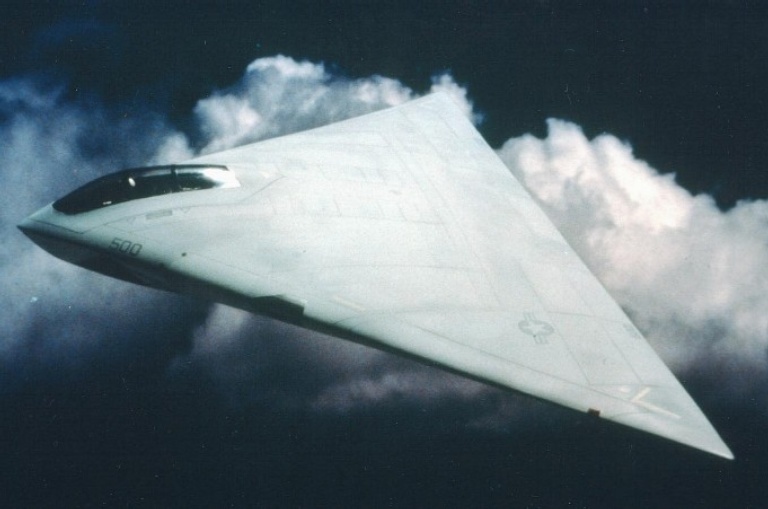
The ill fated A-12A Avenger II was to be a stealthy interdictor
replacing the A-6E and F-111 family. The US Navy envisaged the use of
the long range ATA in conjunction with the navalised ATF to provide a
1000 NM + power projection capability. The ATA was cancelled earlier
this year, as it had become severely overweight and could not meet
design performance requirements with a pair of 12,000 lb class F404
engines. The expense of a major redesign with 18,000 lb class F110
engines was substantial and the US DoD killed the program, leaving the
Navy with a fleet of obsolescent A-6Es. A short term fix is the
adoption
of an enlarged strike derivative of the F/A-18, supplemented by strike
capable F-14Ds. In the longer term, an AX strike aircraft is envisaged,
but no major funding has been allocated at this time.
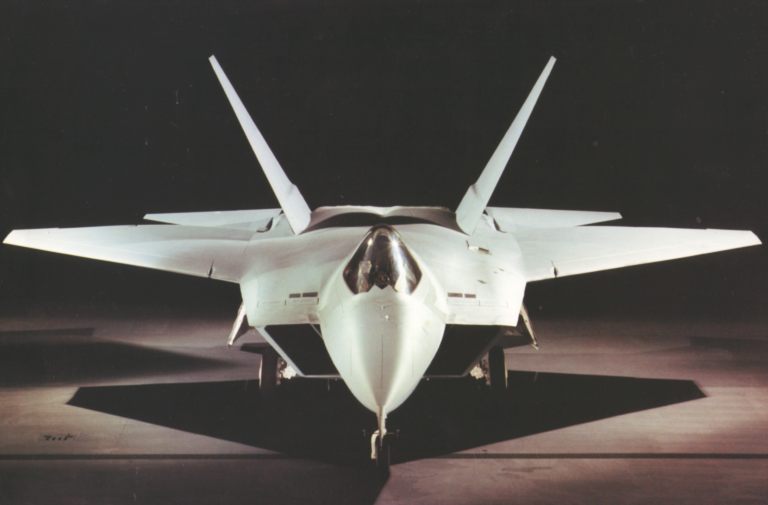
The YF-22 was optimised for agility with some resulting
loss in
stealthiness. The general layout is similar to the F-15 and F/A-18, but
much larger. RCS reduction is achieved largely through planform shaping
and faceting, resulting in a multiple lobe design. Thrust vectoring is
employed to improve pitch response.
The YF-23 was optimised for speed, range and stealth at some expense in
agility, compared to its rival. The general layout is unique and
exploits much of the design technique developed in the B-2A ATB
program.
RCS is reduced through careful planform shaping and blending, with a
unique low drag tail which conceals dorsal exhausts in troughs to
reduce
both RCS and IR emissions (USAF).
The ATF is designed for a 1:1 class dry thrust/weight ratio and
supersonic dry cruise. This provides it with a major energy advantage
over a teen series (or teenski series) opponent, which it can
outmanoeuvre and outlast in a supersonic engagement (USAF).
The ATF will carry its missiles internally to minimise
RCS. Both the
AIM-120 Amraam and AIM-9 are ejected from their bays at launch, so that
the increase in RCS due open bays is transient and thus cannot allow
tracking. The missiles will be supplemented by an internal gun
(USAF/Lockheed/Boeing).
The ATF has been designed for a minimal frontal RCS to provide a major
advantage in the high noon shootout pre-merge phase of an engagement. A
conventional opponent cannot shoot until a lock is acquired, and thus
is
likely to get hit in the face with an Amraam fired by the closing ATF
before he can acquire the ATF. Once a turning engagement is entered,
the
high dry thrust/weight ratio of the ATF will confer a major energy
advantage. A measure of this is a Lockheed report which indicates the
YF-22 dry envelope is greater than the reheated envelope of the F-15C!
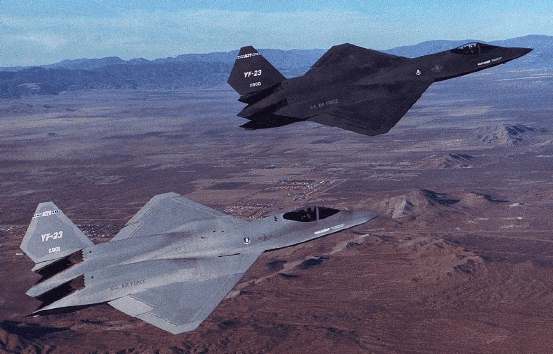
The ATF is designed to be long legged, with 25,000 lb class internal
fuel capacity [Editor's Note 2005: actual production F/A-22A vehicle
capacity is closer to 21,000 lb] supplemented by inflight refuelling.
This provides it with phenomenal range in subsonic cruise and excellent
persistence in supercruise. In strategic air warfare terms, the ATF can
penetrate deep into hostile airspace to defeat defending fighter
aircraft and disrupt any attempts at offensive air operations, the
ultimate application of Lanchester's laws (USAF).
|
![Home - Air Power Australia Website [Click for more ...]](APA/APA-Title-Main.png)
![Sukhoi PAK-FA and Flanker Index Page [Click for more ...]](APA/flanker.png)
![F-35 Joint Strike Fighter Index Page [Click for more ...]](APA/jsf.png)
![Weapons Technology Index Page [Click for more ...]](APA/weps.png)
![News and Media Related Material Index Page [Click for more ...]](APA/media.png)
![Surface to Air Missile Systems / Integrated Air Defence Systems Index Page [Click for more ...]](APA/sams-iads.png)
![Ballistic Missiles and Missile Defence Page [Click for more ...]](APA/msls-bmd.png)
![Air Power and National Military Strategy Index Page [Click for more ...]](APA/strategy.png)
![Military Aviation Historical Topics Index Page [Click for more ...]](APA/history.png)
![Intelligence, Surveillance and Reconnaissance and Network Centric Warfare Index Page [Click for more ...]](APA/isr-ncw.png)
![Information Warfare / Operations and Electronic Warfare Index Page [Click for more ...]](APA/iw.png)
![Systems and Basic Technology Index Page [Click for more ...]](APA/technology.png)
![Related Links Index Page [Click for more ...]](APA/links.png)
![Homepage of Australia's First Online Journal Covering Air Power Issues (ISSN 1832-2433) [Click for more ...]](APA/apa-analyses.png)
![Home - Air Power Australia Website [Click for more ...]](APA/APA-Title-Main.png)
![Sukhoi PAK-FA and Flanker Index Page [Click for more ...]](APA/flanker.png)
![F-35 Joint Strike Fighter Index Page [Click for more ...]](APA/jsf.png)
![Weapons Technology Index Page [Click for more ...]](APA/weps.png)
![News and Media Related Material Index Page [Click for more ...]](APA/media.png)
![Surface to Air Missile Systems / Integrated Air Defence Systems Index Page [Click for more ...]](APA/sams-iads.png)
![Ballistic Missiles and Missile Defence Page [Click for more ...]](APA/msls-bmd.png)
![Air Power and National Military Strategy Index Page [Click for more ...]](APA/strategy.png)
![Military Aviation Historical Topics Index Page [Click for more ...]](APA/history.png)
![Intelligence, Surveillance and Reconnaissance and Network Centric Warfare Index Page [Click for more ...]](APA/isr-ncw.png)
![Information Warfare / Operations and Electronic Warfare Index Page [Click for more ...]](APA/iw.png)
![Systems and Basic Technology Index Page [Click for more ...]](APA/technology.png)
![Related Links Index Page [Click for more ...]](APA/links.png)
![Homepage of Australia's First Online Journal Covering Air Power Issues (ISSN 1832-2433) [Click for more ...]](APA/apa-analyses.png)
![Sukhoi PAK-FA and Flanker Index Page [Click for more ...]](APA/flanker.png)
![F-35 Joint Strike Fighter Index Page [Click for more ...]](APA/jsf.png)
![Weapons Technology Index Page [Click for more ...]](APA/weps.png)
![News and Media Related Material Index Page [Click for more ...]](APA/media.png)
![Surface to Air Missile Systems / Integrated Air Defence Systems Index Page [Click for more ...]](APA/sams-iads.png)
![Ballistic Missiles and Missile Defence Page [Click for more ...]](APA/msls-bmd.png)
![Air Power and National Military Strategy Index Page [Click for more ...]](APA/strategy.png)
![Military Aviation Historical Topics Index Page [Click for more ...]](APA/history.png)
![Information Warfare / Operations and Electronic Warfare Index Page [Click for more ...]](APA/iw.png)
![Systems and Basic Technology Index Page [Click for more ...]](APA/technology.png)
![Related Links Index Page [Click for more ...]](APA/links.png)
![Homepage of Australia's First Online Journal Covering Air Power Issues (ISSN 1832-2433) [Click for more ...]](APA/apa-analyses.png)